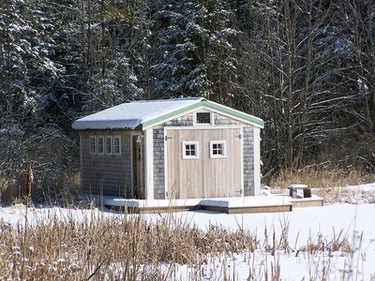Things You'll Need
Foam board panels
Glue
Duct tape
Vapor sheeting
Plywood or OSB
Razor knife
Galvanized nails
Hammer
Caulk

Insulating a metal shed roof with rigid foam can be done one of three ways — by laying the board prior to applying the roof, by removing the existing roof and installing new foam board, or by insulating the existing metal roof from the inside. Rigid foam boards come in different material compositions, varying thicknesses and different insulating (R-value) properties. Cost will vary substantially, too, depending on which kind of insulation you use. Determine beforehand how much R-value you need. A shed used to store tools won't need much, if any, insulation, while a shed in which you spend time working will require considerably more.
Step 1
Remove the existing roof, if you have one. Lay and attach plywood or OSB (oriented-strand board) to the exterior roofing structure of the shed. Be sure to use stainless steel or galvanized nails. If the shed is all-metal construction, you'll have to construct a wooden framing network to accept the plywood or OSB underlayment.
Video of the Day
Step 2
Attach a weather-proofing or vapor-resistant sheet of material over the plywood.
Step 3
Measure the roof area and cut your rigid foam boards to fit by scoring it with a razor knife and snapping the board at the incisions. Most foam board comes in 8 feet x 4 feet sheets, although different sizes are available (8 feet x 2 feet is common). There are typically 10 to a pack.
Step 4
Glue the foam boards to the plywood roofing in a vertical direction. Use a glue designed for foam board adhesion and follow manufacturers' directions for the amount to use, temperature requirements and curing times. Glues come in both spray-on versions and caulk-gun types. Do not butt the foam boards tightly together; leave a small seam (1/8 inch) between panels.
Step 5
Duct tape the seams.
Step 6
Attach firing strips in a horizontal direction across the foam board, beginning at the top. Attach a strip along the top ridge, then to the bottom ridge, then one strip in the center. Use more strips if needed, centering each additional strip between other rows.
Step 7
Re-attach the metal roof to the firing strips using galvanized nails. Caulk around the nail heads to prevent water penetration. This not only prevents damage to the foam board, but it creates a small pocket between the board and metal roof to allow for air flow.
Tip
Foam insulation R-values range from R-4 to R-8 per inch of thickness, which is two to three times greater than most other materials of the same thickness. The most common types of materials used in making foam board include polystyrene, polyisocyanurate or polyiso, and polyurethane.
Warning
Molded expanded polystyrene (MEPS) can be shaped into a lot of everyday items, such as coffee cups and shipping materials, or into sheets of foam board insulation. MEPS foam board insulation often is called beadboard. Beadboard roofing insulation must be dense enough to walk on. Wall insulation foam boards are much less dense than roof boards, so be careful when choosing your product. Some foam panel insulation is rigid enough to skip the step of installing a plywood sub-roof, but these materials are expensive and have weight-load restrictions, which can be an important consideration for roofs where snow can accumulate.
Video of the Day